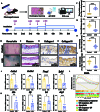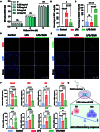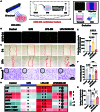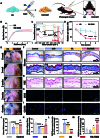Decellularized Adipose Matrix Rejuvenates Photoaged Skin through Immune Microenvironment Modulation
- PMID: 40761470
- PMCID: PMC12320489
- DOI: 10.34133/bmef.0166
Decellularized Adipose Matrix Rejuvenates Photoaged Skin through Immune Microenvironment Modulation
Abstract
Objective: This study aims to explore the therapeutic potential of decellularized adipose matrix (DAM) in rejuvenating photoaged skin by modulating the immune microenvironment. Impact Statement: DAM effectively induces M1 to M2 macrophage polarization and rescues the function of photoaged fibroblasts through paracrine mechanisms, providing a novel strategy for skin antiaging through immune microenvironment remodeling. Introduction: Photoaging, triggered by prolonged ultraviolet exposure, is marked by the depletion of skin structural elements and a persistent inflammatory environment. Current clinical interventions primarily target structural defects, while immune modulation remains underexplored. Therefore, developing biomaterials with both extracellular matrix (ECM) replenishment and immune regulatory functions is crucial for skin regeneration. Methods: A photoaged mouse model was established using ultraviolet B irradiation to validate the inflammatory microenvironment. DAM was prepared via physicochemical decellularization and assessed in vitro for its effects on macrophage polarization and macrophage-fibroblast cross-talk. A DAM-functionalized hyaluronic acid (HA/DAM) hydrogel was developed and evaluated for its effects on skin rejuvenation via subcutaneous injection. Results: In vitro experiments demonstrated that DAM substantially promoted M2 macrophage polarization, and M2-macrophage-conditioned medium further improved fibroblast functions, including oxidative stress resistance, migration, and ECM synthesis. In vivo, HA/DAM hydrogel not only increased dermal thickness and collagen density but also restructured the immune microenvironment through M2 macrophage polarization. Conclusion: DAM offers a novel therapeutic approach for skin rejuvenation by modulating the immune microenvironment, demonstrating notable clinical potential.
Copyright © 2025 Jialiang Zhou et al.
Conflict of interest statement
Competing interests: The authors declare that they have no competing interests.
Figures






Similar articles
-
T16 modulated extracellular matrix remodeling in fibroblasts via paracrine activation of TGF-β1 through M2 macrophage polarization.Mol Biol Rep. 2025 Jun 26;52(1):642. doi: 10.1007/s11033-025-10733-7. Mol Biol Rep. 2025. PMID: 40569521
-
Investigation of the effect and mechanism of Fei Re Pu Qing powder in treating acute lung injury (ALI) by modulating macrophage polarization via serum pharmacology and network pharmacology.J Ethnopharmacol. 2025 Jul 24;351:120089. doi: 10.1016/j.jep.2025.120089. Epub 2025 Jun 9. J Ethnopharmacol. 2025. PMID: 40499803
-
Harmine inhibits oxidative phosphorylation, thus regulating the polarization of macrophages mediated by extracellular adenosine in endometriosis.Hum Reprod. 2025 Jul 29:deaf130. doi: 10.1093/humrep/deaf130. Online ahead of print. Hum Reprod. 2025. PMID: 40730246
-
The M2 Macrophages Importance Role in Psoriasis.Immun Inflamm Dis. 2025 Jun;13(6):e70211. doi: 10.1002/iid3.70211. Immun Inflamm Dis. 2025. PMID: 40539722 Free PMC article. Review.
-
Unlocking the regenerative properties of extraembryonic membrane-derived biomaterials in tissue engineering.Acta Biomater. 2025 Jul 16:S1742-7061(25)00527-6. doi: 10.1016/j.actbio.2025.07.028. Online ahead of print. Acta Biomater. 2025. PMID: 40680916 Review.
References
-
- Gordon JRS, Brieva JC. Images in clinical medicine. Unilateral dermatoheliosis. N Engl J Med. 2012;366(16): Article e25. - PubMed
-
- Yaar M, Gilchrest BA. Photoageing: Mechanism, prevention and therapy. Br J Dermatol. 2007;157(5):874–887. - PubMed
-
- Green AC, Hughes MCB, McBride P, Fourtanier A. Factors associated with premature skin aging (photoaging) before the age of 55: A population-based study. Dermatology. 2011;222(1):74–80. - PubMed
-
- Green AC. Premature ageing of the skin in a Queensland population. Med J Aust. 1991;155(7):473–474. - PubMed
-
- Pega F, Momen NC, Streicher KN, Leon-Roux M, Neupane S, Schubauer-Berigan MK, Schüz J, Technical Advisory Group on Occupational Burden of Disease Estimation, Baker M, Driscoll T, et al. Global, regional and national burdens of non-melanoma skin cancer attributable to occupational exposure to solar ultraviolet radiation for 183 countries, 2000–2019: A systematic analysis from the WHO/ILO joint estimates of the work-related burden of disease and injury. Environ Int. 2023;181: Article 108226. - PubMed
LinkOut - more resources
Full Text Sources

